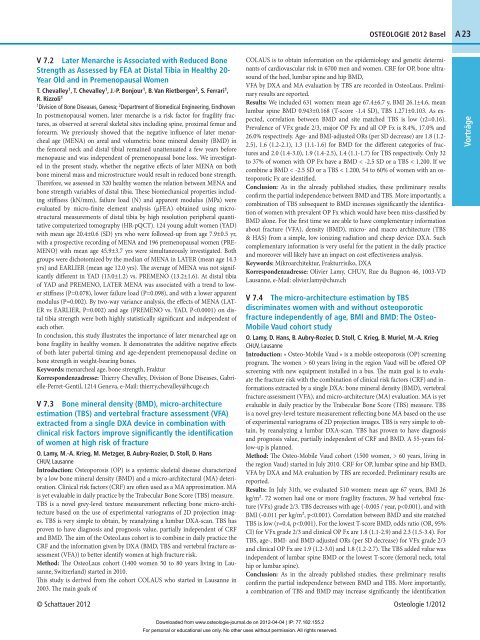Schlüsselwörter - Osteologie Kongress 2012
Schlüsselwörter - Osteologie Kongress 2012
Schlüsselwörter - Osteologie Kongress 2012
Erfolgreiche ePaper selbst erstellen
Machen Sie aus Ihren PDF Publikationen ein blätterbares Flipbook mit unserer einzigartigen Google optimierten e-Paper Software.
V 7.2 later Menarche is Associated with Reduced Bone<br />
Strength as Assessed by FEA at Distal Tibia in Healthy 20-<br />
Year Old and in Premenopausal Women<br />
T. Chevalley1 , T. Chevalley1 , J.-P. Bonjour1 , B. Van Rietbergen2 , S. Ferrari1 ,<br />
R. Rizzoli1 1Division of Bone Diseases, Geneva; 2Department of Biomedical Engineering, Eindhoven<br />
In postmenopausal women, later menarche is a risk factor for fragility fractures,<br />
as observed at several skeletal sites including spine, proximal femur and<br />
forearm. We previously showed that the negative influence of later menarcheal<br />
age (MENA) on areal and volumetric bone mineral density (BMD) in<br />
the femoral neck and distal tibial remained unattenuated a few years before<br />
menopause and was independent of premenopausal bone loss. We investigated<br />
in the present study, whether the negative effects of later MENA on both<br />
bone mineral mass and microstructure would result in reduced bone strength.<br />
Therefore, we assessed in 320 healthy women the relation between MENA and<br />
bone strength variables of distal tibia. These biomechanical properties including<br />
stiffness (kN/mm), failure load (N) and apparent modulus (MPa) were<br />
evaluated by micro-finite element analysis (µFEA) obtained using microstructural<br />
measurements of distal tibia by high resolution peripheral quantitative<br />
computerized tomography (HR-pQCT). 124 young adult women (YAD)<br />
with mean age 20.4±0.6 (SD) yrs who were followed-up from age 7.9±0.5 yr,<br />
with a prospective recording of MENA and 196 premenopausal women (PRE-<br />
MENO) with mean age 45.9±3.7 yrs were simultaneously investigated. Both<br />
groups were dichotomized by the median of MENA in LATER (mean age 14.3<br />
yrs) and EARLIER (mean age 12.0 yrs). The average of MENA was not significantly<br />
different in YAD (13.0±1.2) vs. PREMENO (13.2±1.6). At distal tibia<br />
of YAD and PREMENO, LATER MENA was associated with a trend to lower<br />
stiffness (P=0.078), lower failure load (P=0.098), and with a lower apparent<br />
modulus (P=0.002). By two-way variance analysis, the effects of MENA (LAT-<br />
ER vs EARLIER, P=0.002) and age (PREMENO vs. YAD, P 60 years living in the region Vaud will be offered OP<br />
screening with new equipment installed in a bus. The main goal is to evaluate<br />
the fracture risk with the combination of clinical risk factors (CRF) and informations<br />
extracted by a single DXA: bone mineral density (BMD), vertebral<br />
fracture assessment (VFA), and micro-architecture (MA) evaluation. MA is yet<br />
evaluable in daily practice by the Trabecular Bone Score (TBS) measure. TBS<br />
is a novel grey-level texture measurement reflecting bone MA based on the use<br />
of experimental variograms of 2D projection images. TBS is very simple to obtain,<br />
by reanalyzing a lumbar DXA-scan. TBS has proven to have diagnosis<br />
and prognosis value, partially independent of CRF and BMD. A 55-years follow-up<br />
is planned.<br />
Method: The Osteo-Mobile Vaud cohort (1500 women, > 60 years, living in<br />
the region Vaud) started in July 2010. CRF for OP, lumbar spine and hip BMD,<br />
VFA by DXA and MA evaluation by TBS are recorded. Preliminary results are<br />
reported.<br />
Results: In July 31th, we evaluated 510 women: mean age 67 years, BMI 26<br />
kg/m². 72 women had one or more fragility fractures, 39 had vertebral fracture<br />
(VFx) grade 2/3. TBS decreases with age (-0.005 / year, p


